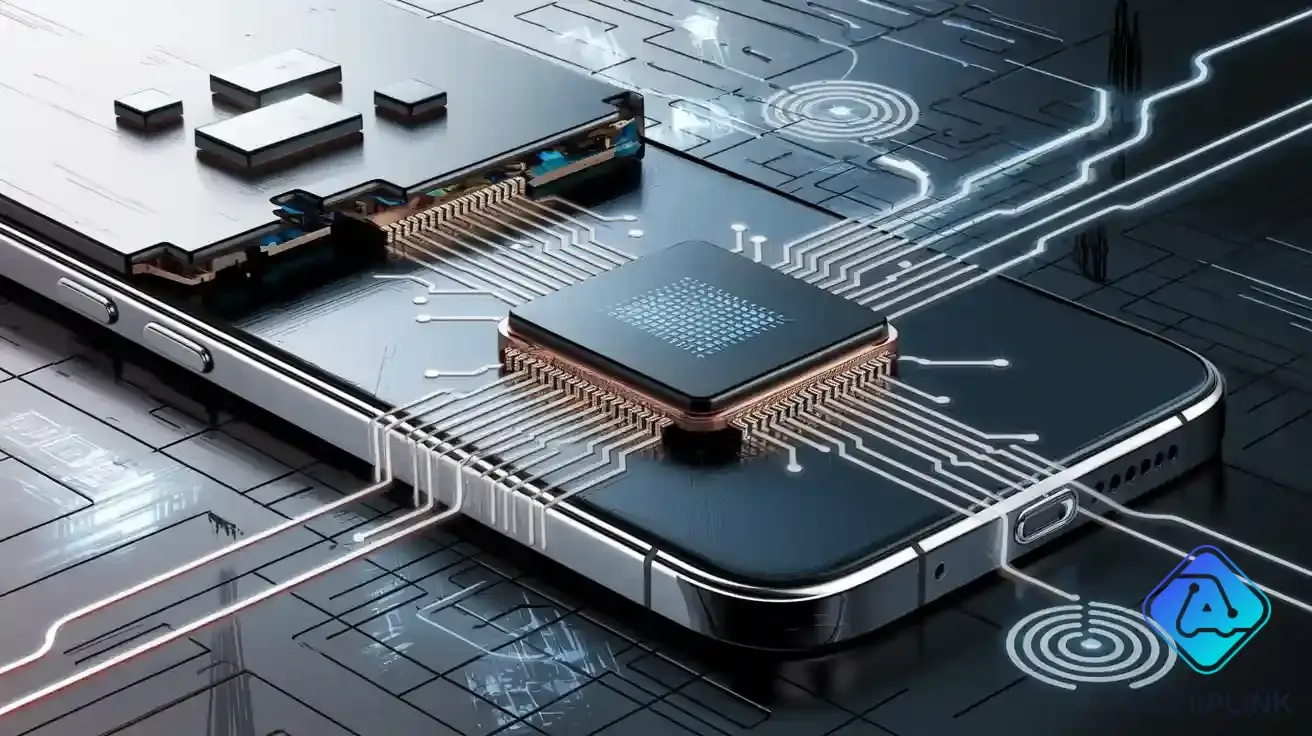
5G devices need advanced RF components to work with higher frequencies, wider bandwidths, and tricky signal situations. These parts are very important for faster data speeds, better network capacity, and steady connections.
-
5G uses new spectrum bands like mmWave. This lets devices reach speeds up to 10 Gbps. Devices can also use many antennas for massive MIMO.
-
Advanced parts handle wide bandwidths, beamforming, and higher-order modulation. This helps keep strong connections even when it is hard.
Knowing why these parts matter helps people who care about wireless technology see how 5G gives steady connections.
Key Takeaways
-
5G devices use higher frequencies and wider bandwidths. These need advanced RF parts to keep signals fast and strong.
-
Advanced RF components help lower interference and manage heat. They also help fit many antennas into small devices. This gives better connections.
-
New antenna technologies like beamforming and massive MIMO help signal quality. They also help network capacity in busy places.
-
RF front-end modules and semiconductor chips work together. They make 5G devices smaller, more efficient, and reliable.
-
These advanced RF parts help new things like smart cities and self-driving cars. They also help IoT and get networks ready for the future.
5G Devices and Technical Demands
Higher Frequencies
5g devices use more frequencies than older wireless types. They work with sub-6 GHz bands and mmWave bands up to 52 GHz. This helps 5g give faster speeds and better connections in busy cities.
The table below shows how different wireless generations use different frequency ranges:
| Generation | Frequency Range (Typical) | Notes |
|---|---|---|
| 2G & 3G | 850 MHz - 2100 MHz | Mostly GSM and early 3G bands |
| 4G | 600 MHz - 2.5 GHz | Expanded bands including LTE |
| 5G Sub-6 GHz | 450 MHz - 6 GHz | Includes previous cellular bands |
| 5G mmWave | 24 GHz - 52 GHz | New high-frequency bands |
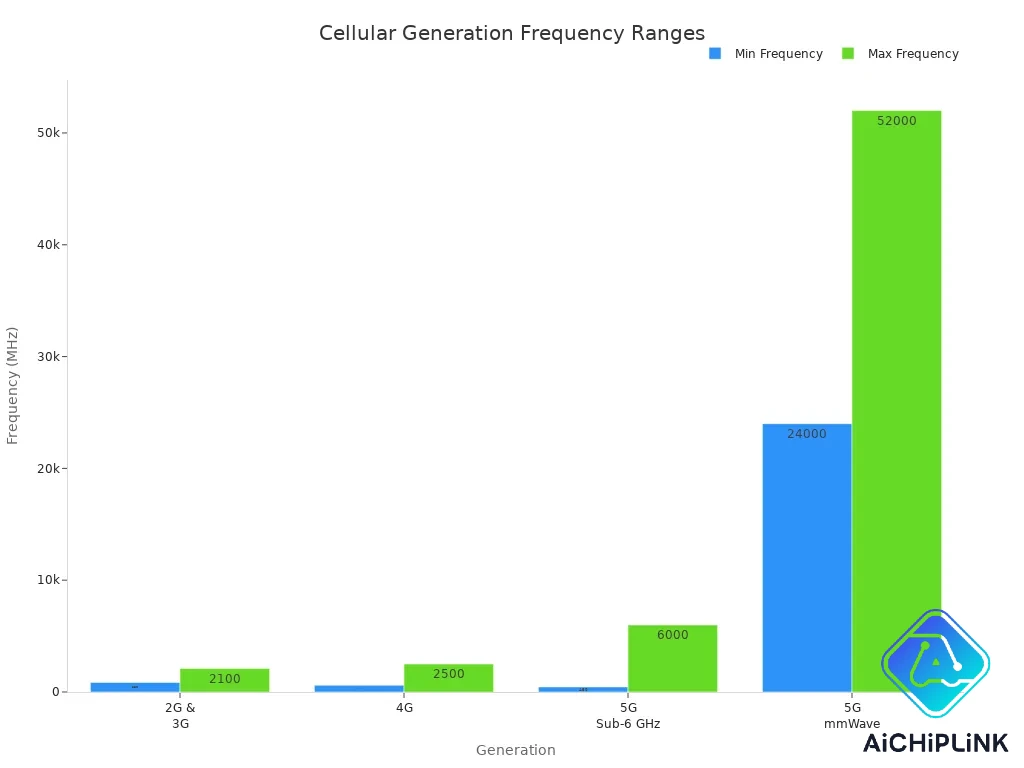
Using higher frequencies lets 5g devices support fast speeds and many iot devices. But these frequencies can make signals weaker. Devices need advanced radio-frequency parts to help. Engineers use more antennas and careful layouts to keep signals strong. Phones and other devices need special materials and smart designs to solve these problems.
Wider Bandwidths
5g devices need to handle much wider bandwidths than 4G. Wider bandwidths let more data move at once. This means faster speeds and more capacity.
The table below compares 5g and 4G bandwidth and speed:
| Aspect | 5G Bandwidth / Speed | 4G Bandwidth / Speed |
|---|---|---|
| Channel Bandwidth | 100 MHz to 800 MHz (mmWave) | 1.4 MHz to 20 MHz |
| Speed Range | 50 Mbps to over 2 Gbps (up to 20 Gbps in lab) | 5 Mbps to 300 Mbps (LTE-A peak) |
| Frequency Bands | Wide spectrum including mmWave | Mainly lower frequency bands |
Wider bandwidths make new problems for radio-frequency parts. Devices must fit more antennas and circuits into small spaces. This makes phones and iot products more complex. Engineers also need to control heat and power use. More parts working together can make more heat. Advanced rf filters and antennas help keep signals clear and strong, even as devices get smaller and more powerful.
Low Latency
5g networks want very low latency, often about 1 millisecond. Low-latency rf connections help important things like self-driving cars and factory robots. Delays can cause trouble in these cases.
To do this, 5g devices use advanced radio-frequency parts like special antennas and smart rf modules. These parts help make connections fast, steady, and less likely to have problems.
Low latency means 5g and iot devices must process signals quickly and correctly. Engineers use new frame designs and timing controls to cut delays. But these changes make rf parts harder to design. Phones and iot devices need exact timing and syncing to keep up with 5g speed and connections.
Note: Ultra-low latency in 5g lets iot, remote surgery, and smart factories work in real time. This makes advanced radio-frequency design very important for future technology.
Multi-Band Operation
5g devices need to work with many frequency bands to connect everywhere. Multi-band operation means a device can use low, mid, and high bands. This is important because countries use different bands for 5g. Supporting many bands helps phones and iot devices stay connected and work well everywhere.
Multi-band operation makes radio-frequency parts more complicated. Devices need advanced antenna tuning and small designs to fit many antennas in one case. The table below shows how multi-band operation affects rf parts in 5g devices:
| Aspect | Impact of Multi-Band Operation on RF Components in 5G Devices |
|---|---|
| Frequency Bands Supported | Multiple bands increase design complexity in rf front-end modules |
| Power Levels | Higher power classes require robust filters and thermal management |
| Integration | Highly integrated modules reduce size and improve efficiency |
| Coexistence Management | Careful control of noise and isolation maintains sensitivity |
| Antenna Design | Tuning and miniaturization fit multiple bands in small devices |
| Multi-Technology Integration | Adds system complexity and requires advanced manufacturing |
| Thermal and Efficiency Challenges | Improved management needed for longer transmit durations |
| Component Innovation | Use of new filter and switch technologies for performance |
Multi-band and multi-technology integration also let 5g and iot devices use Wi-Fi, Bluetooth, and other wireless types. This helps phones and iot products give smooth connections and strong performance, even as networks and apps get more complex.
Radio-Frequency Challenges in 5G
Signal Integrity
5g devices must keep signals clear at high frequencies. Radio-frequency pcb design has many problems with millimeter-wave bands. These bands can go up to 100 GHz. Engineers must control gain, noise, and linearity in all rf parts. Small changes in trace width or dielectric thickness can cause impedance mismatches. This can make signals weak or change them.
-
Controlled impedance design means engineers do math for trace widths and dielectric thickness. This keeps the right impedance, usually 50 Ω.
-
Shorter traces and no sharp bends help stop signal loss.
-
Via optimization matters because each via adds extra capacitance and inductance.
Using low-loss materials like PTFE-based laminates helps stop signal loss above 1 GHz. Good thermal management with heat sinks and thermal vias keeps rf parts cool. Ground planes under rf traces help signals by giving a good return path.
System-on-Chip designs and advanced packaging, like 3D stacking, make electrical paths shorter. This makes data move faster and cuts down on delay. AI and machine learning now help design antennas and circuits. This makes radio-frequency pcb layouts work better.
Interference Management
Interference is a big problem for radio-frequency pcb design in 5g. Many kinds of interference can hurt rf parts. Passive intermodulation happens when signals mix in antennas or cables. TDD networks can have signals overlap if not synced. Devices near airports or borders can get cross-system interference.
To stop interference, engineers use:
-
Careful setup to avoid loose connections and rust.
-
Filters for certain frequencies to block bad signals.
-
Directional antennas to aim signals and cut noise.
-
Low noise amplifiers to make weak signals stronger without adding noise.
-
Checking and fixing problems often to catch them early.
The chart below shows how different filtenna designs help stop interference and keep signals clear in 5g radio-frequency pcb systems:
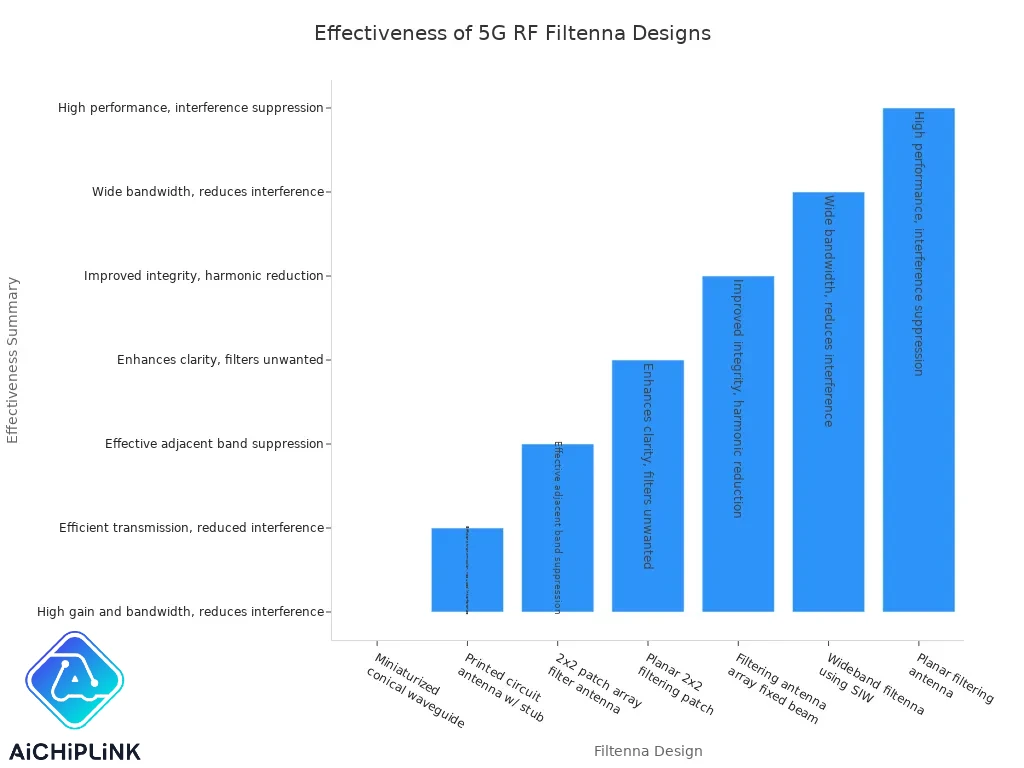
As 5g networks get bigger in cities, interference gets worse. Advanced signal processing and interference coordination help keep communication clear.
Miniaturization
Modern 5g devices need many radio-frequency pcb parts in small spaces. Miniaturization brings new problems. Engineers must fit more antennas, filters, and amplifiers into small devices. High-frequency use above 50 GHz needs exact impedance matching and high isolation between pins.
-
Antennas inside packages save space but are harder to tune.
-
Testing gets harder with many antennas and test spots.
-
Advanced materials like good ceramics and special substrates help electrical work and keep things stable.
-
Modular designs and multi-use connectors help with multi-band and multi-protocol communication.
The table below shows some miniaturization problems and ways to fix them for radio-frequency pcb parts in 5g devices:
| Challenge Area | Description and Impact on 5G Miniaturization |
|---|---|
| High-Precision Patterning | Smaller lines and spaces help control impedance and line up layers. |
| Thermal Management | Built-in heat spreading and planning for both electrical and heat needs. |
| Packaging Integration | Putting antennas, transceivers, and passives together in smaller spaces. |
| RF Front-End Density | More parts packed together with tricky signal paths and power networks. |
| Testing & Calibration | Special tools and built-in FPGAs help test at high frequencies. |
Miniaturization lets 5g devices stay small and strong. New research and materials help engineers solve these radio-frequency pcb design problems.
Advanced RF PCB Design Solutions
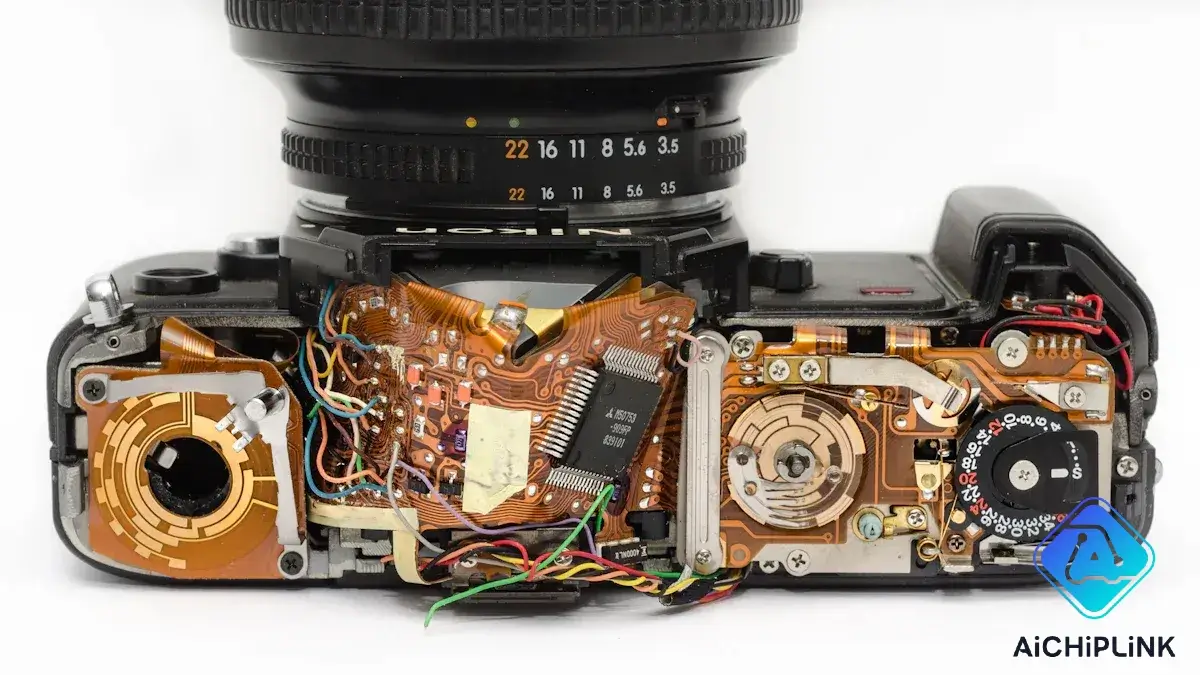
Modern 5G devices need advanced rf pcb design. Engineers use special methods to make filtering and amplification work well. These solutions help devices use higher frequency bands and wider bandwidths. They also help in tough signal situations. The next parts show how radio-frequency components and technologies work together in 5G devices.
RF Filters and Amplifiers
RF filters and amplifiers are very important in rf pcb design for 5G. Filters split signals by frequency and block noise. Some filter types are Surface Acoustic Wave (SAW), Bulk Acoustic Wave (BAW), and Film Bulk Acoustic Resonator (FBAR). These filters help with multi-band operation and tunable frequency ranges. This is needed for 5G’s tricky spectrum. Multiplexers and antennaplexers mix many radio-frequency paths. This means fewer antennas are needed and helps carrier aggregation.
Engineers check filter performance using things like insertion loss, return loss, passband, stopband, and Q factor. Low insertion loss and high Q factor mean better signals. BAW filters use Bragg reflectors to manage heat. FBAR filters use air cavities for high-frequency work. Layered SAW filters help keep temperature steady.
Amplifiers make signals stronger in radio-frequency circuits. Doherty amplifiers, outphasing amplifiers, and envelope tracking amplifiers are used in 5G. Doherty amplifiers are efficient but need digital predistortion to fix distortion. Outphasing amplifiers use phase control for better bandwidth. Envelope tracking changes the power supply in real time. This keeps amplifiers efficient and saves power. Engineers measure amplifier gain, one dB compression point (P1dB), linearity, and efficiency to make sure they work well.
| Component Type | Role in 5G Devices and Base Stations | Market Share / Usage (2024) |
|---|---|---|
| Power Amplifiers (PA) | Make signals stronger and use less energy; GaN-based amplifiers help with heat | 19% of RF devices; 34% more used in 2023-2024 |
| Filters | Stop signal interference in many frequency bands; multi-band and tunable filters are needed for 5G | 22% of base station RF devices |
| Low Noise Amplifiers (LNA) | Help receive signals with little distortion, important for mmWave and Massive MIMO | 14% of RF modules |
Advanced rf pcb design uses these filters and amplifiers to keep signals clear and strong. GaN-based power amplifiers and envelope tracking can lower power use by up to 80%. These upgrades help 5G devices get fast data speeds and steady connections.
Antenna Technologies
Antenna technology has improved a lot for 5G’s high-frequency needs. Engineers use smart antennas like beamforming and massive MIMO to make signals better. Beamforming antennas send radio-frequency energy toward users. This cuts down on interference and makes connections stronger. Massive MIMO antennas use many channels at once. This helps send and receive more signals and boosts network capacity.
| Antenna Type | Description | How It Improves Signal Quality and Coverage |
|---|---|---|
| MIMO Antennas | Use many channels at the same time | Makes data move faster and networks work better |
| External 5G Antennas | Put outside homes or devices to catch stronger signals | Helps reception in places with weak signals |
| Directional Antennas | Point signals in one direction | Makes range and speed better by aiming at 5G towers |
| Outdoor Antennas | Put outside to catch far signals | Works better in places with weak coverage |
| High-Gain Antennas | Make weak signals stronger | Makes signals stronger and steadier, even in bad spots |
| 5G Antenna Boosters | Make 5G signals stronger | Help in dead zones or places with bad coverage |
Adaptive antenna tuning changes settings in real time to make things work better. This tech watches the environment and network, then changes antenna settings to help signals and speed. MIMO and beamforming work together to lower interference and keep connections steady, even in busy cities. AI-powered antenna tuning, like Qualcomm’s Snapdragon X70 modem-RF, uses smart programs to sense where users are and how busy the network is. This helps make data move faster and coverage better.
Distributed repeaters and antenna boosters help in places with weak signals. These devices catch, fix, and send radio-frequency signals again. This helps 5G devices keep strong connections around things that block signals.
RF Front-End Modules
RF front end modules put amplifiers, filters, mixers, and switches together in small units. These modules help send and receive radio-frequency signals in 5G devices. Engineers make rf front end modules to work with sub-6 GHz and millimeter-wave bands. This lets devices connect easily and get fast data in different places.
RF front end modules fix problems like signal interference and power use. They help IoT devices talk well even when things change. Miniaturization and integration let many parts—like low noise amplifiers, power amplifiers, phase shifters, and switches—fit on one chip. This helps beamforming in antenna groups and makes radio designs smaller and use less power.
One example is the ADTR1107 IC from Analog Devices. This chip works from 6 to 18 GHz and has a power amplifier, low-noise amplifier, and switch in a tiny package. It helps phased-array antennas by giving high gain and low noise. It can switch quickly between sending and receiving. This shows how rf front end modules help make things smaller and work well in 5G.
| Key Performance Indicator (KPI) | 4G RF Front-End Modules | 5G RF Front-End Modules |
|---|---|---|
| Frequency Range | Mostly sub-6 GHz | Sub-6 GHz and mmWave (above 24 GHz) |
| Component Density | Medium density | Higher density because of more parts and smaller size |
| Integration Level | Lower integration, separate parts | High integration, many functions in one module (e.g., AiP) |
| Power Amplifier Technology | GaAs-based amplifiers | More GaN used for better power and efficiency |
| Filter Technology | SAW/BAW filters | Better transmission line filters for mmWave |
| Packaging and EMI Shielding | Regular packaging, basic EMI shielding | Better packaging (antenna-in-package), stronger EMI shielding |
| Thermal Management | Normal thermal solutions | Better thermal materials and management |
| Architectural Complexity | Simple designs | Complex designs with beamforming ICs |
Note: 5G rf front end modules need more integration, better materials, and improved thermal management than 4G.
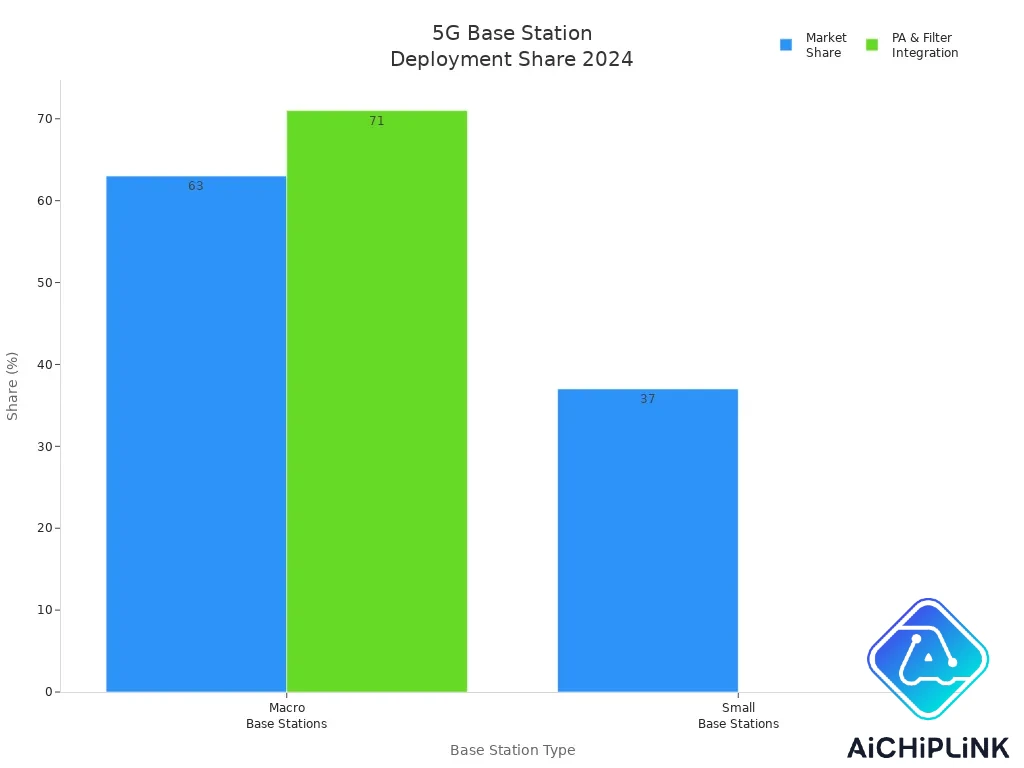
Semiconductor Chips
Semiconductor chips are the main part of strong rf front-end modules in 5G devices. Engineers use materials like Gallium Nitride (GaN) and Silicon Carbide (SiC) because they handle high power and work at high frequency. CMOS technology helps make chips cheaper and easier to build.
Good plastics like PEEK, PTFE, and polycarbonate help with heat and EMI shielding in rf pcb design. These materials make devices stable and tough, which is needed for good radio-frequency work.
New chips use miniaturization to fit more transistors and jobs on one chip. This lets processing, memory, and connections all be in one place. FinFET transistors help control current and stop leaks, making chips use less energy. RF-SOI technology lets amplifiers, switches, and filters all go on one chip. This makes chips smaller and signals better.
-
RF-SOI chips have low insertion loss, high linearity, and fewer harmonics.
-
Putting more parts together makes chips smaller and batteries last longer.
-
FD-SOI types let power change and work at low voltage, making things run better and use less power.
These chip upgrades help advanced rf pcb design. They support massive MIMO, carrier aggregation, and fast data processing. This means 5G devices work well, save energy, and handle tough radio-frequency situations.
Advanced rf front-end solutions work because rf pcb design, strong rf front-end modules, and new semiconductor chips all help each other. This teamwork makes sure 5G devices give fast, steady, and efficient wireless communication.
Benefits of Advanced RF Components in 5G
Performance and Reliability
Advanced radio-frequency parts help 5G devices work well and stay connected. These parts handle high frequency signals and wider bandwidths. Engineers use them to stop signal loss and block interference. Devices with advanced radio-frequency technology keep connections steady, even when many people use them at once. Antenna tuning and making parts smaller let devices use many frequency bands. This helps phones, routers, and IoT sensors talk clearly.
Reliable connections mean people have fewer dropped calls and faster data.
Low latency in 5G and IoT networks helps things work in real time. Robots, self-driving cars, and health systems need fast response times. Advanced radio-frequency parts make this possible by keeping signals strong.
Support for Emerging Applications
Radio-frequency parts are important for new uses. Massive IoT and edge computing need devices that connect lots of sensors and machines.
-
5G and IoT networks use very reliable, low-latency links for important jobs.
-
Massive machine-type communication helps smart cities and connected systems.
-
Better spectral efficiency and network slicing make custom networks for different IoT needs.
-
Using AI and machine learning makes networks work better and use less energy.
-
Advanced radio-frequency parts put 5GNR, Wi-Fi 6, Bluetooth, and GNSS/GPS together in small modules.
These features help more homes, factories, and cities use the internet of things. Devices can move lots of data and connect to many systems at once.
Makers build radio-frequency parts for high data, low power, and long-range links.
This lets people use video streaming, security cameras, and factory robots.
Future Scalability
5G and IoT networks grow with scalable radio-frequency solutions. Advanced radio-frequency parts help networks get bigger and add new tech.
Studies show that adding more antennas and scaling massive MIMO systems meets future needs. New spectrum bands in the upper mid-band give more choices and space.
-
AI in radio-frequency design helps signals stay strong.
-
Carrier aggregation joins many frequency bands for more speed and space.
-
Smaller radio-frequency modules help wearables and smart gadgets.
Market trends show the radio-frequency front end market will grow as more devices use 5G and IoT. Billions of devices will connect, so high-performance radio-frequency parts are needed.
Companies use materials like gallium nitride and silicon carbide to make parts work better and stay cool.
These upgrades make sure 5G and IoT networks can change and support new uses in the future.
Advanced RF components are very important for 5G devices. They help fix problems with high frequencies and wide bandwidths. They also help with security risks. Engineers use new materials and modular designs to make things work better. This helps iot and smart city projects grow. Companies want faster and safer connections. Cars and iot devices need strong RF parts for safe and steady communication.
-
New materials like gallium nitride make devices work better and stay cool.
-
Smart spectrum management and cognitive radio help networks get bigger.
-
Working with regulators helps get spectrum faster and solves health worries.
-
Using AI and machine learning in RF design makes devices work better.
-
Massive MIMO and beamforming help signals reach more places and more people.
-
Small cells and advanced RF filters help in busy city areas.
-
Better RF front-end modules help devices use more frequency bands.
-
More healthcare, car, and factory uses mean more need for flexible RF parts.
-
Companies spend money on research and better designs to keep up with 5G and iot growth.
-
More 5G networks mean more need for strong and efficient RF devices.
Learning about RF technology helps engineers and companies keep up with fast changes and stay ahead in 5G. The future of iot and wireless communication needs new ideas in RF components.
FAQ
What makes 5G RF components different from 4G?
5G RF components handle higher frequencies and wider bandwidths. They use better materials and new designs. These changes help devices send and get data faster and more reliably.
Why do 5G devices need more antennas?
5G devices have more antennas for things like massive MIMO and beamforming. More antennas make signals stronger, boost speed, and help coverage in crowded places.
Tip: More antennas give better connections, especially where it is busy.
How do advanced RF filters help 5G devices?
Advanced RF filters block signals you do not want and cut down interference. They keep the main signal clear. This helps 5G devices keep strong and steady connections.
Can older devices use 5G networks with new RF components?
| Device Type | 5G Compatibility | Upgrade Needed? |
|---|---|---|
| 4G Smartphone | No | Yes |
| 5G Smartphone | Yes | No |
| IoT Sensor | Sometimes | Often |
Older devices need new RF components to work with 5G networks. Most cannot upgrade easily.

Written by Jack Elliott from AIChipLink.
AIChipLink, one of the fastest-growing global independent electronic components distributors in the world, offers millions of products from thousands of manufacturers, and many of our in-stock parts is available to ship same day.
We mainly source and distribute integrated circuit (IC) products of brands such as Broadcom, Microchip, Texas Instruments, Infineon, NXP, Analog Devices, Qualcomm, Intel, etc., which are widely used in communication & network, telecom, industrial control, new energy and automotive electronics.
Empowered by AI, Linked to the Future. Get started on AIChipLink.com and submit your RFQ online today!
Frequently Asked Questions
What makes 5G RF components different from 4G?
5G RF components handle higher frequencies and wider bandwidths. They use better materials and new designs. These changes help devices send and get data faster and more reliably.
Why do 5G devices need more antennas?
5G devices have more antennas for things like massive MIMO and beamforming. More antennas make signals stronger, boost speed, and help coverage in crowded places. Tip: More antennas give better connections, especially where it is busy.
How do advanced RF filters help 5G devices?
Advanced RF filters block signals you do not want and cut down interference. They keep the main signal clear. This helps 5G devices keep strong and steady connections.
Can older devices use 5G networks with new RF components?
Device Type 5G Compatibility Upgrade Needed? 4G Smartphone No Yes 5G Smartphone Yes No IoT Sensor Sometimes Often Older devices need new RF components to work with 5G networks. Most cannot upgrade easily.














